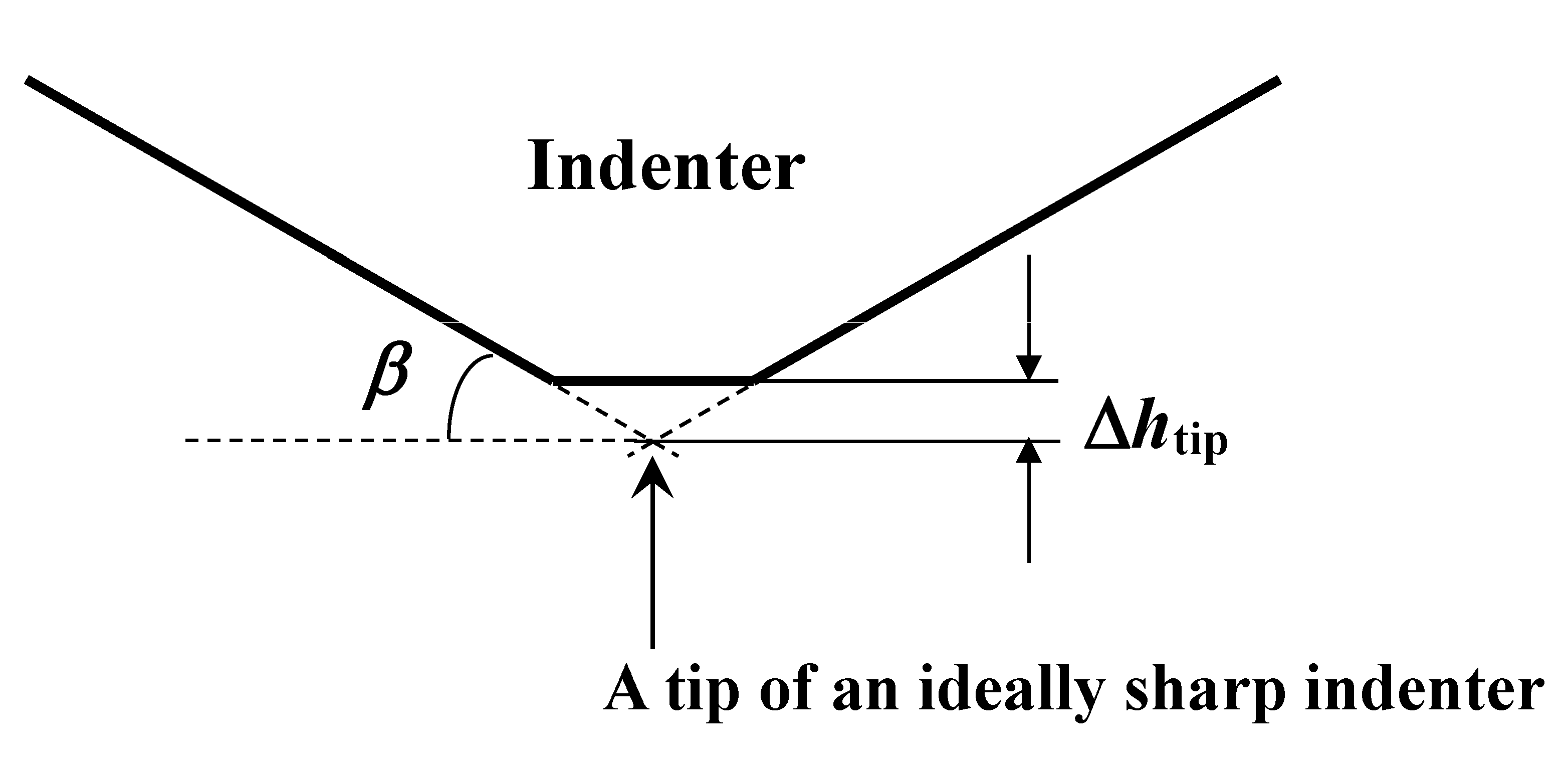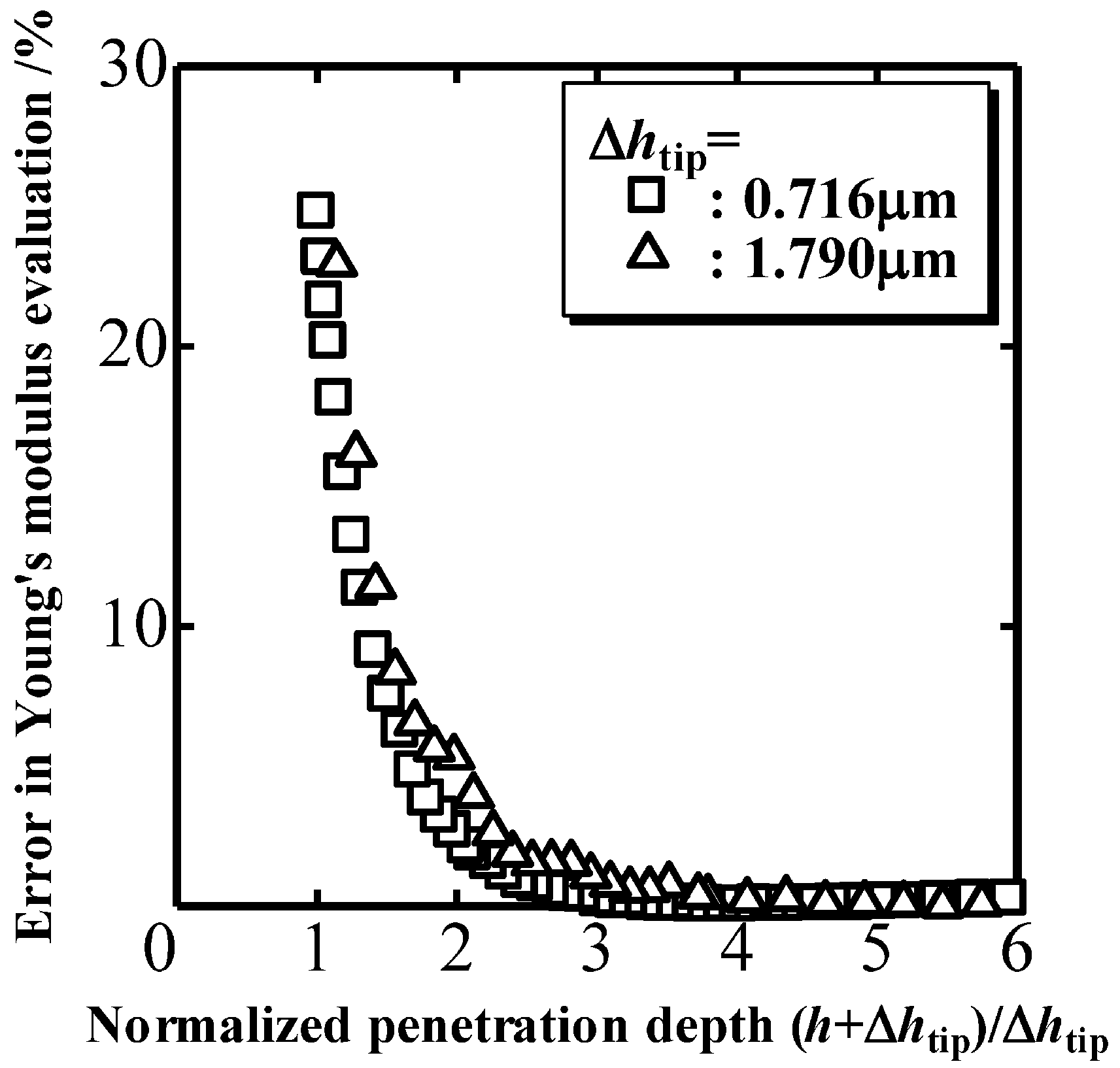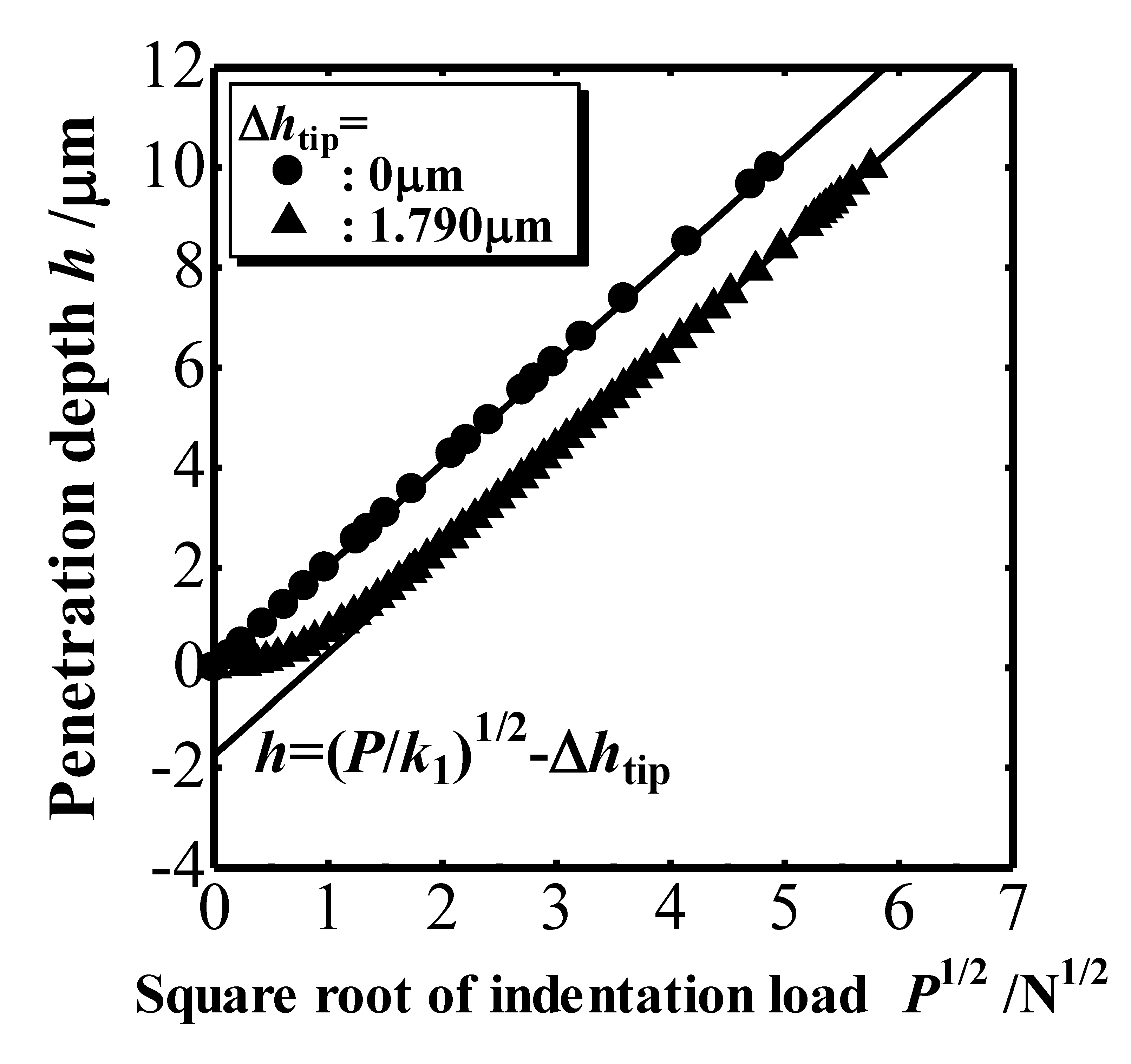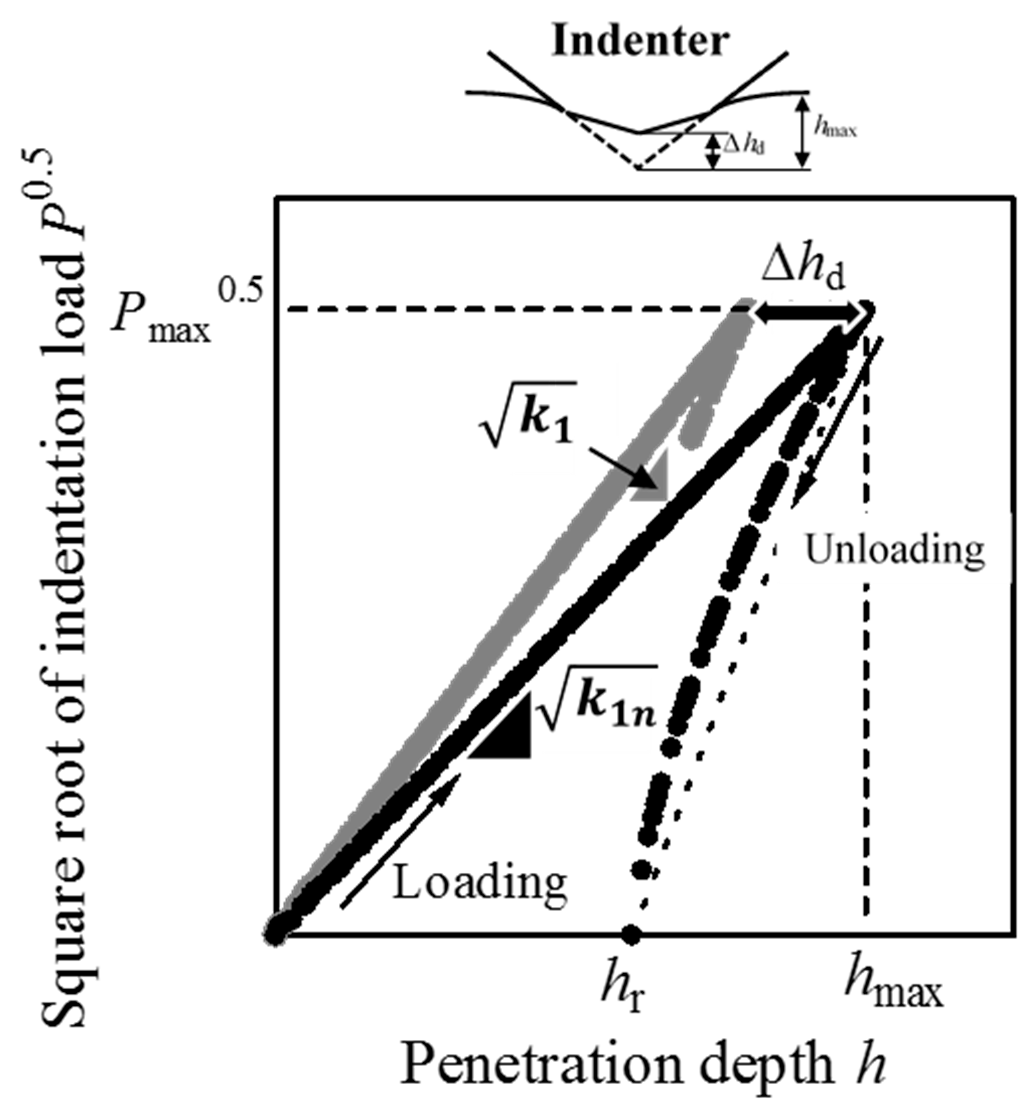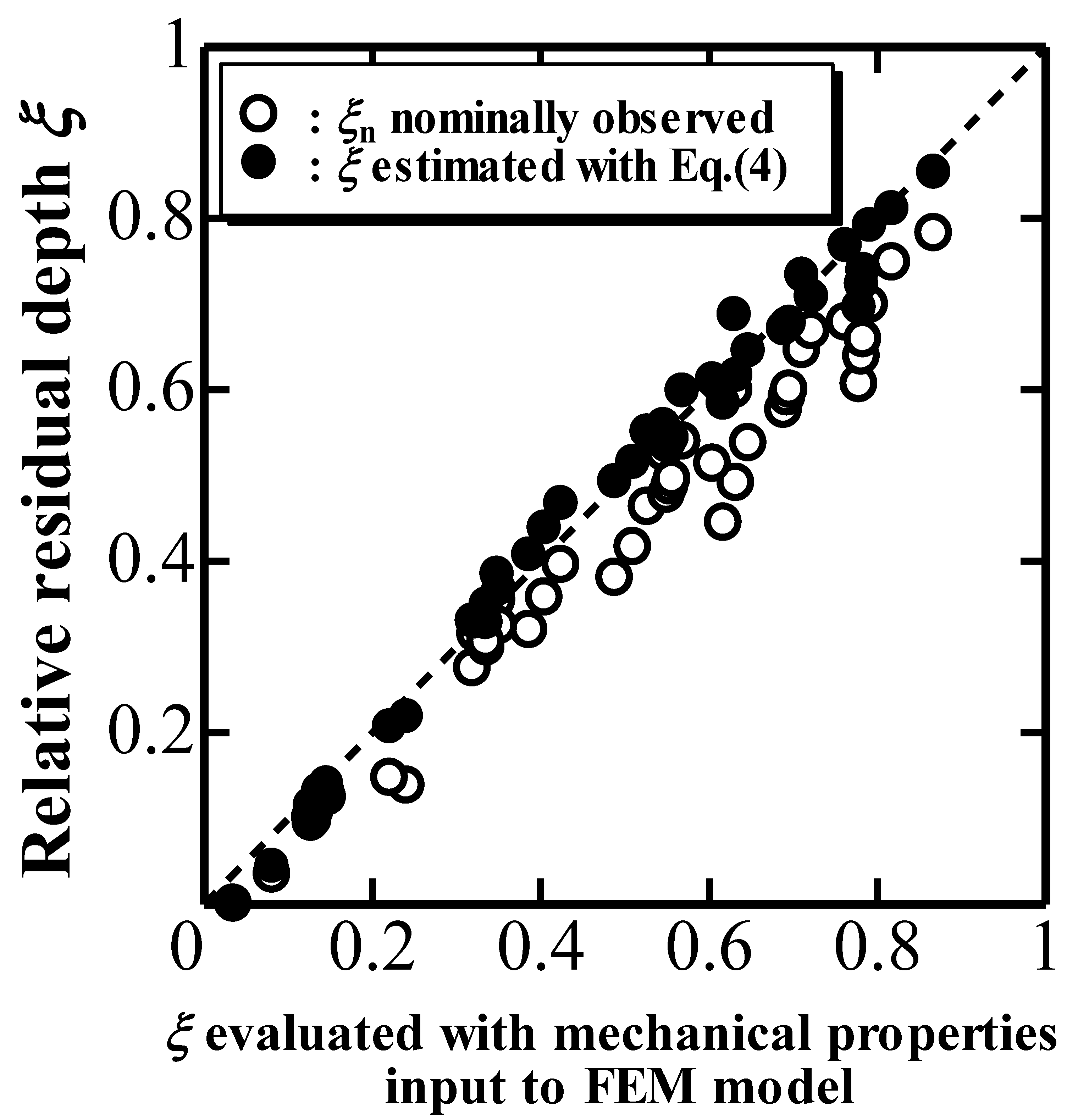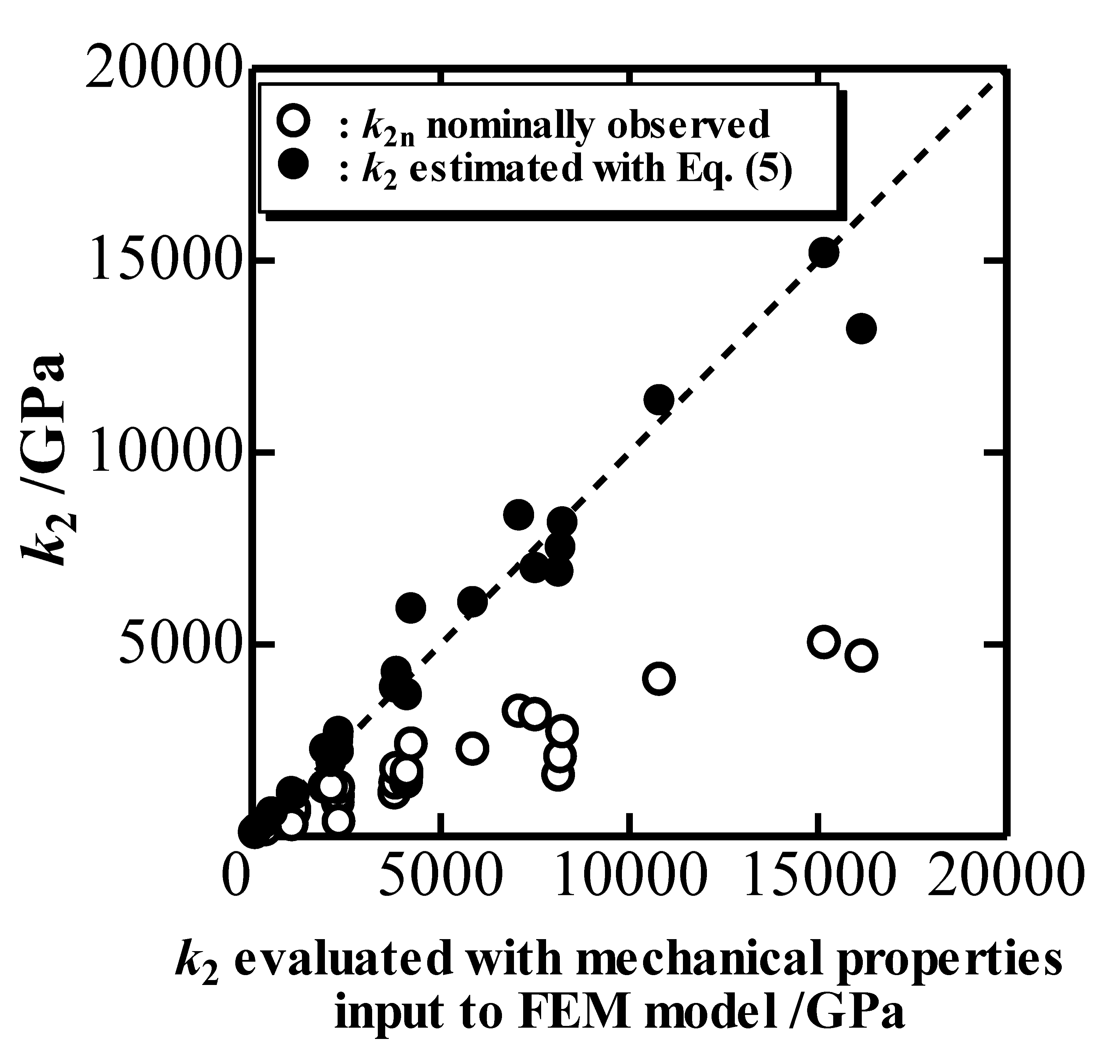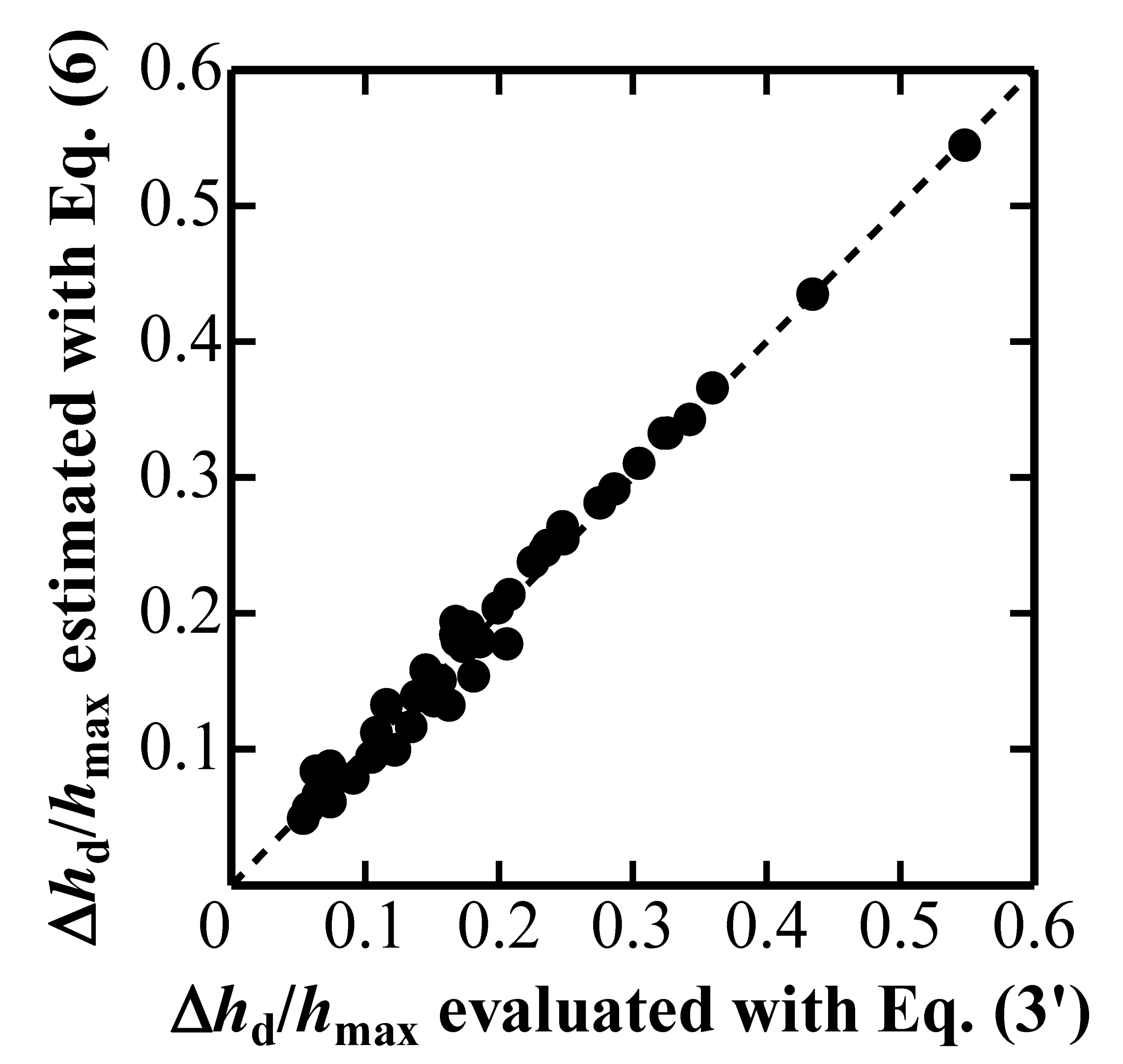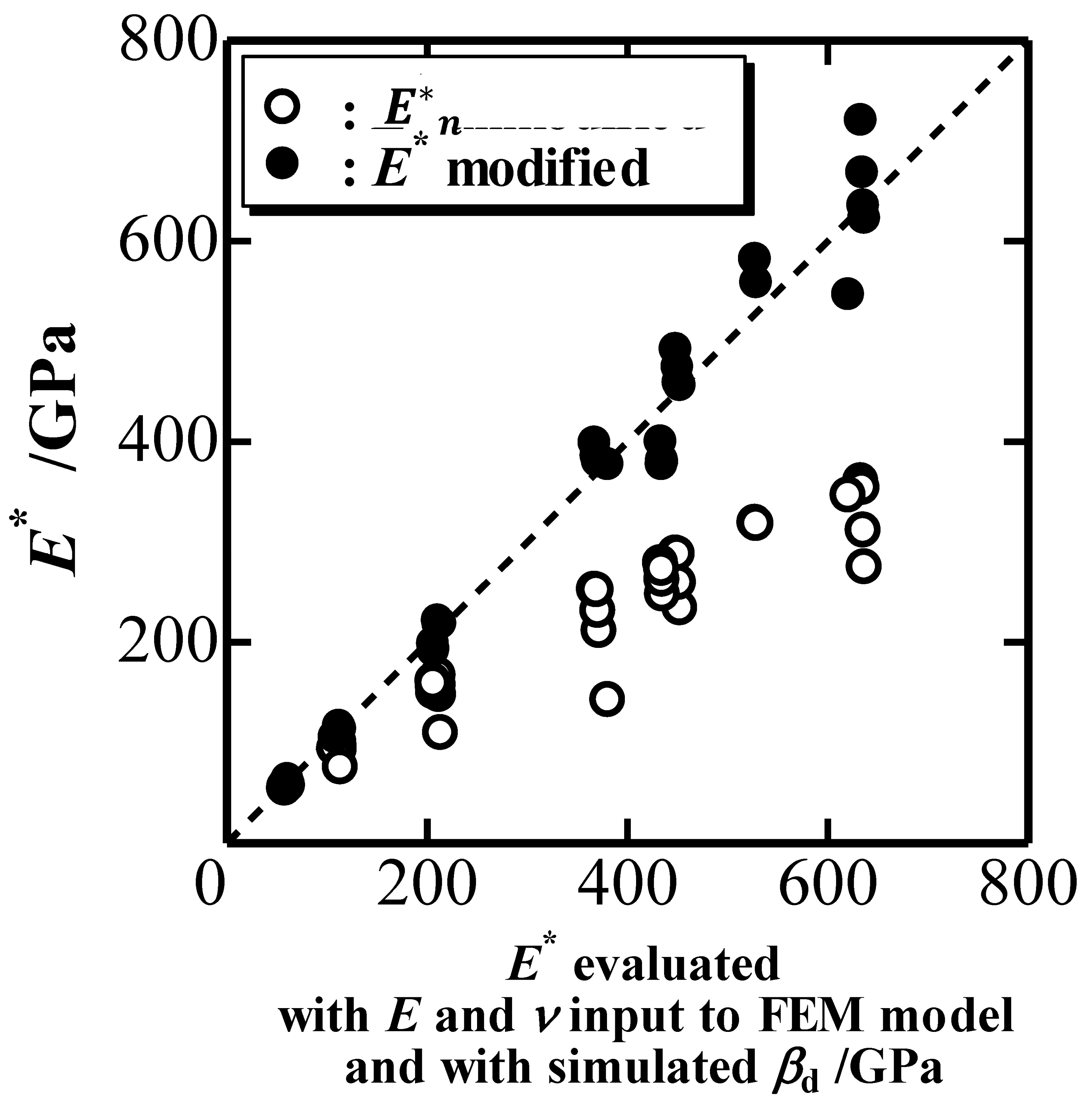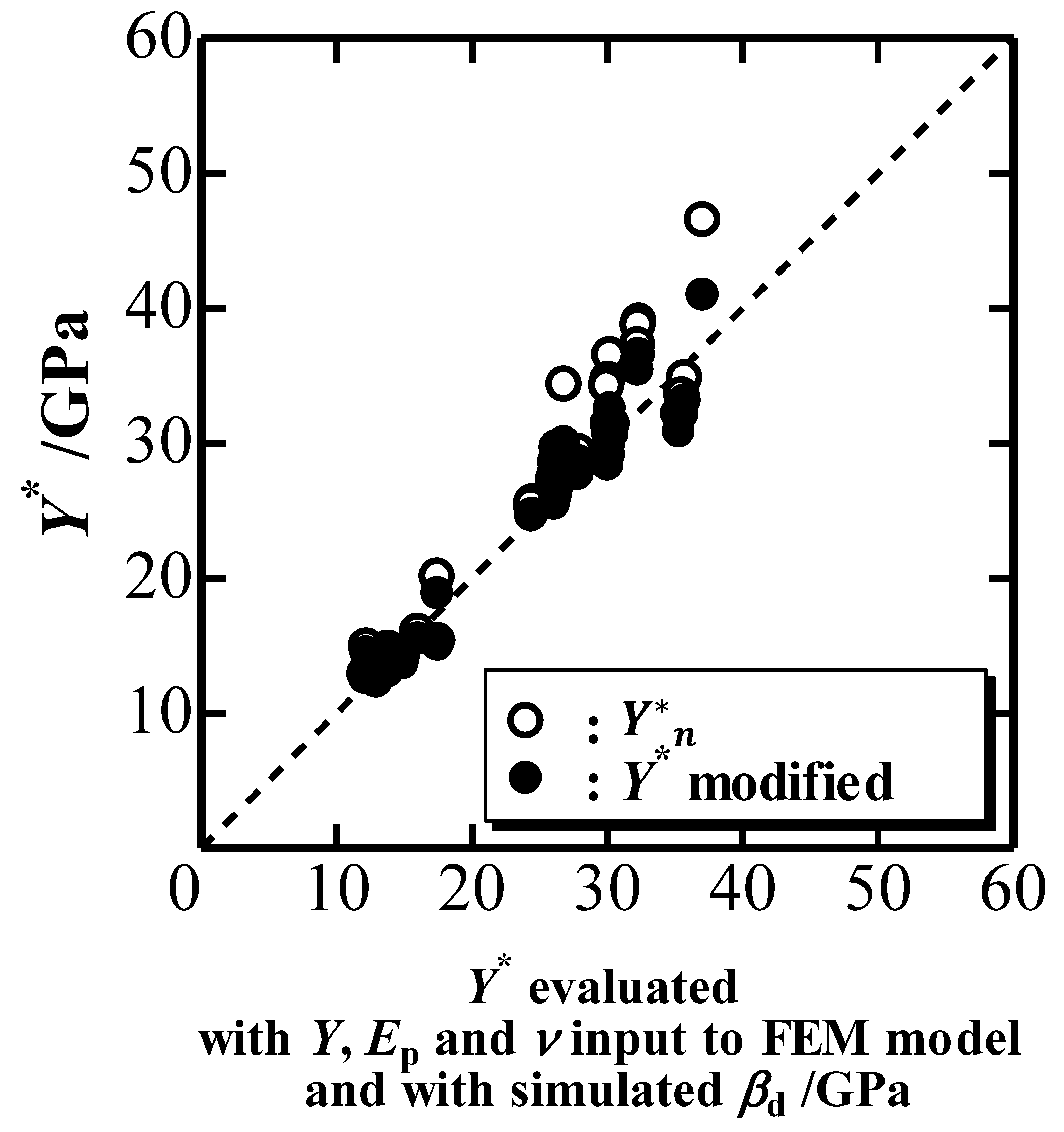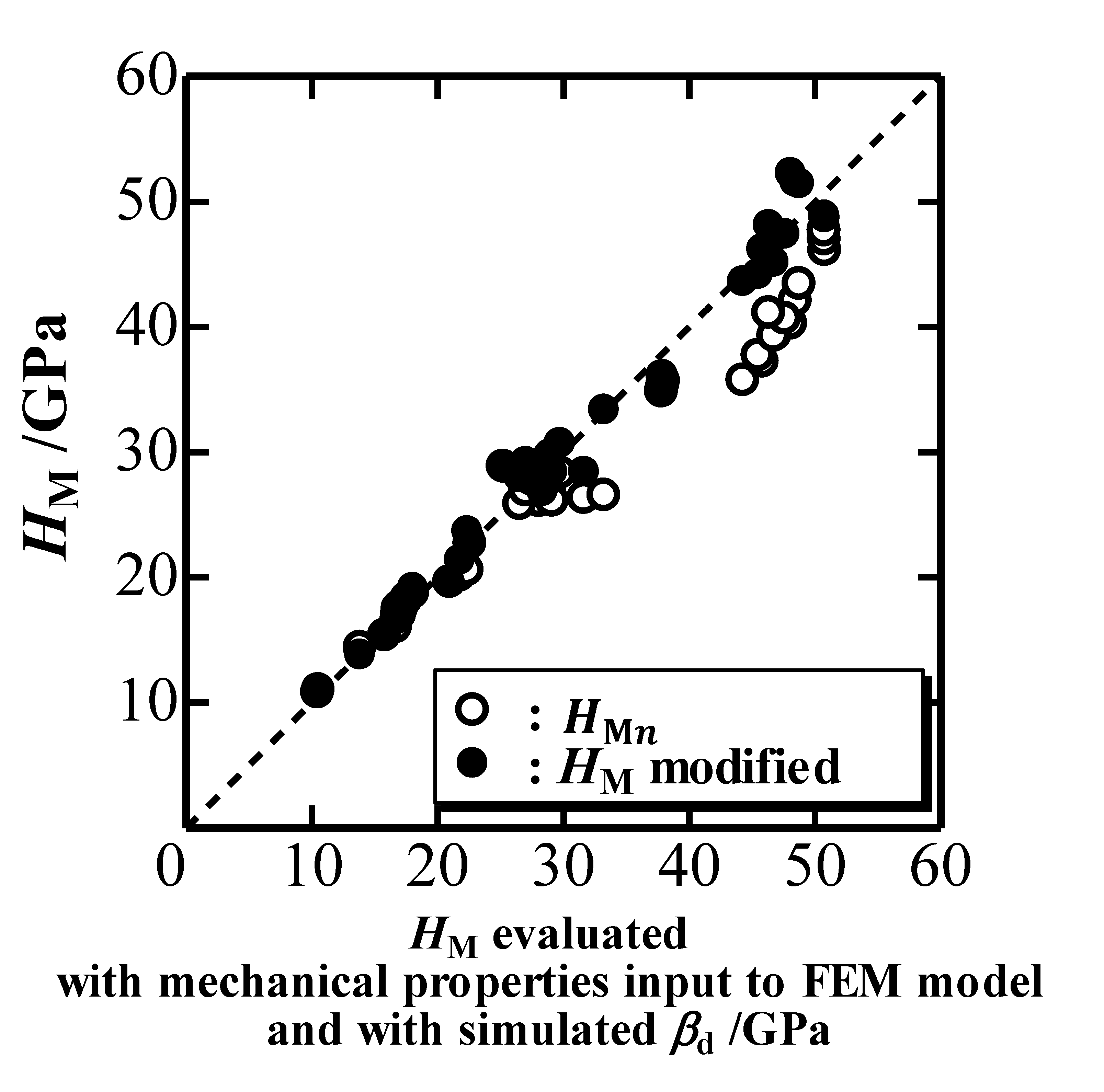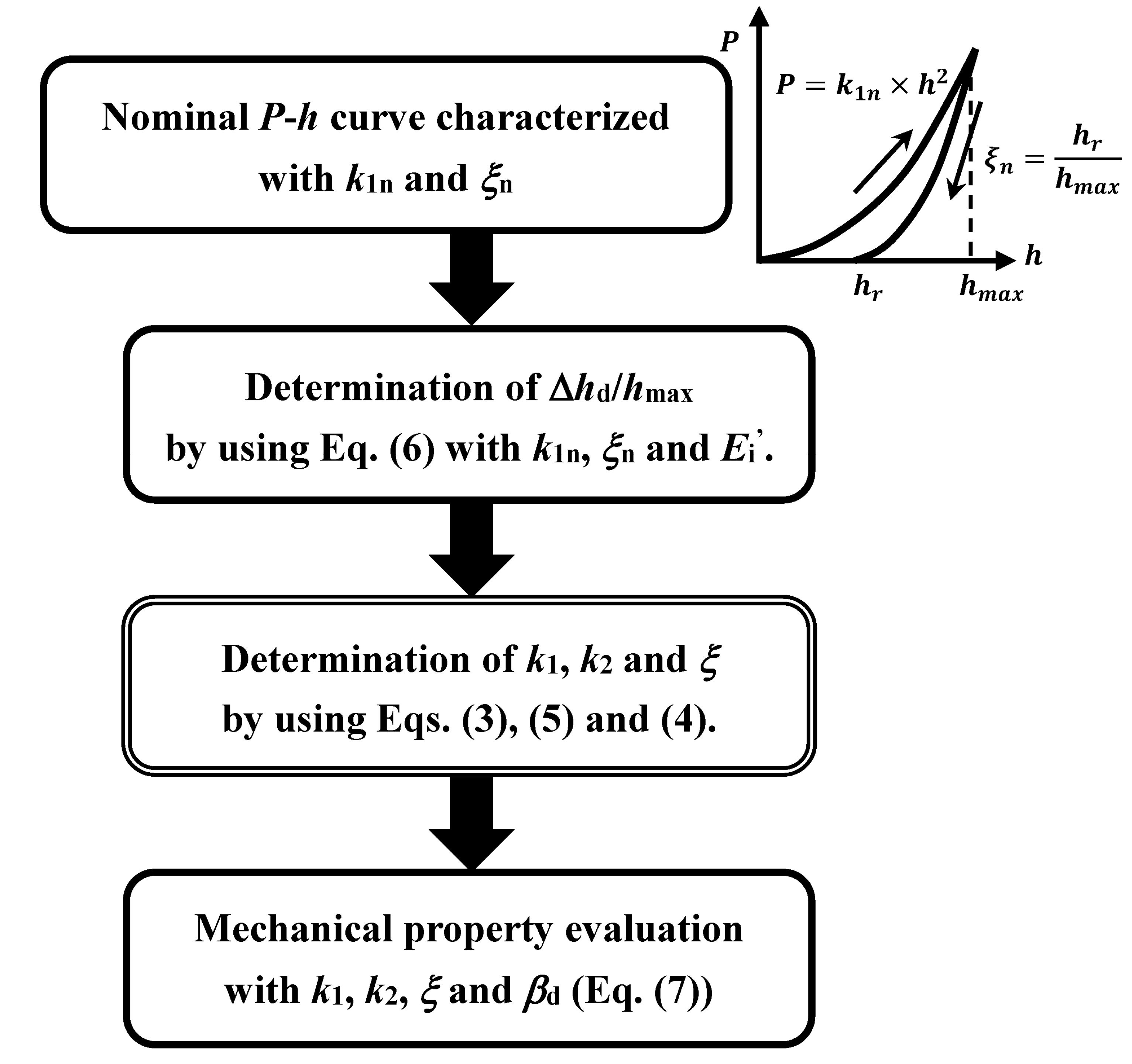1. Introduction
Nanoindentation is a form of mechanical testing characterized as a depth-sensing indentation [
1] to evaluate local mechanical properties through the analysis of the indentation load
P versus the penetration depth
h (
P-
h curve, hereafter). The analysis is principally based on a geometrical definition in which the indentation is carried out on a flat surface using an indenter geometrically defined such as flat-ended, spherical, ellipsoidal, point-sharp (e.g., conical, Berkovich, Vickers, cube corner, etc.). The point-sharp indentation has an advantage in local mechanical testing owes to the analytical simplicity for the geometrical similarity [
2].
The bluntness of the indenter tip is one of the inevitable problems of undesirable tip geometry, especially for the point-sharp indentations, because it is impossible to make an ideally sharp indenter. The degree of the bluntness of a point-sharp indenter has been expressed in terms of the radius of curvature at the tip [
3,
4,
5], but the actual geometry of a blunt tip is not guaranteed to be spherical. An area function [
6,
7] which gives the projected contact area at the maximum indentation load is another approach to express the bluntness of a point-sharp indenter, but the area function is theoretically valid only for hardness evaluation. A truncated tip which represents a blunt tip in an extremely poor situation [
8] is a suitable model for a strict discussion on the effect of the tip bluntness on indentation behavior. According to the appendix of this paper, where a truncated tip is considered, the undesirable effect of the bluntness of a point-sharp indenter can be removed out simply if the
P-
h curve is shifted with Δ
htip in the
h direction for indentations deeper than 2Δ
htip, where Δ
htip is the distance between ideally sharp and blunt tips (see
Figure A1,
Figure A2,
Figure A3 and
Figure A4). In addition, Δ
htip can be estimated through an extrapolation of the linear relationship between
h and
P*** observed in the large
P and
h region to
P = 0 (see
Figure A5).
The elastic deformation of an actual point-sharp indenter, which has been conventionally taken into account on the basis of Hertzian contact [
6]; Hertzian contact was basically used for spherical indentations as a modification of the elastic modulus evaluation. It is also an inevitable problem of undesirable tip geometry, especially for indentations on a very hard material, and there is still some controversy whether the modification based on the Hertzian contact can be applied to point-sharp indentations. Moreover, there are no reports on the modifications of the indenter elastic deformation for other mechanical properties such as the indentation hardness or yield stress. The geometrical changes of a point-sharp indenter due to elastic deformation should be considered when evaluating local mechanical properties with the nanoindentation technique.
In this paper, the effect of the elastic deformation of a point-sharp indenter on a P-h curve is quantified in a numerical analysis of conical nanoindentation behaviors simulated with the finite element method (FEM). In addition, a procedure of deriving physically meaningful P-h curves, which should be utilized for mechanical property evaluation. Finally, the validity and accuracy of this method is examined.
3. Results and Discussion
A quadratic relationship between
P and
h on loading is theoretically guaranteed for a point-sharp indentation on the flat surface of a homogeneous elastoplastic solid [
11,
12]. The quadratic relationship was also observed in simulated
P-
h curves made with an elastic cone indenter. This indicates that the elastic deformation of a cone indenter can be described as a decrease in
β determined regardless of
h. Therefore, nominal indentations made with an elastic cone indenter with an original inclined face angle
βo should be physically equivalent to indentations made with a rigid cone indenter with the decreased inclined face angle
βd.
A nominal quadratic
P-
h relationship for an elastic cone indenter can be depicted as follows:
where
k1n is the nominal indentation loading parameter. Here,
h in Equation (1) is the nominal penetration depth because the decrease in
β from
βo to
βd, due to the elastic deformation of a cone indenter, gives a decrease in real penetration depth. Thus, a physically meaningful
P-
h relationship can be written with a true indentation loading parameter
k1, which should be observed in a
P-
h loading curve using a rigid cone indenter with
βd as
where Δ
hd is the decrease in
h at the maximum penetration depth
hmax due to the elastic deformation of a cone indenter (see
Figure 1). The combination of Equations (1) and (2) leads to the equation:
This means that Δ
hd/
hmax is a key parameter to estimating
k1 from the nominal
k1n. In other words, Δ
hd/
hmax can be simulated as
where
k1n in Equation (3’) is observed in a simulated
P-
h loading curve with an elastic cone indenter and
k1 in Equation (3’) is evaluated with the mechanical properties inputted into the FEM model [
9,
10]. In the following paragraph, the effect of Δ
hd/
hmax on a
P-
h curve is examined quantitatively through numerical analysis.
In addition to
k1, the relative residual penetration depth
ξ, defined as
hr/
hmax, where
hr is the residual penetration depth, characterizes a
P-
h curve and nominally decreased by the elastic deformation of a cone indenter to be
ξn. A true
ξ-value, which should be observed in a
P-
h curve using a rigid cone indenter with
βd, can also be evaluated with the mechanical properties inputted into the FEM model [
9,
10]. The numerical analysis revealed that the evaluated
ξ can be correlated with the nominal
ξn as a function of Δ
hd/
hmaxFigure 2 plots
ξ estimated with Equation (4) and
ξn against the true
ξ evaluated with the mechanical properties inputted into the FEM model [
9,
10]. The results indicate the validity of using Equation (4) to estimate
ξ from the nominal
ξn and Δ
hd/
hmax. In addition, it is confirmed that
ξn is smaller than
ξ because of the overestimation of the penetration depth
h due to the elastic deformation of the indenter. Moreover, a true indentation unloading parameter
k2 defined as
Pmax/(
hmax −
hr)*, which should be observed in an
P-
h unloading curve using a rigid cone indenter with
βd, can be estimated from a simulated
P-
h curve with an elastic cone indenter characterized by
k1n and
ξn using Equations (3) and (4) as
Figure 3 plots the estimated
k2 with Equation (5) as well as the nominal indentation unloading parameter
k2n determined from a simulated
P-
h curve with an elastic cone indenter against the true
k2 evaluated with the mechanical properties inputted into the FEM model [
9,
10].
Figure 3 indicates that
k2 can be estimated correctly by using Equation (5) with Δ
hd/
hmax, and that the nominal
k2n is quite far from
k2 owing to the overestimation of
h.
The numerical analysis also revealed that Δ
hd/
hmax is determined to be
where
Ei′ is defined as
Ei/(1 −
νi*) and
Ei and
νi are Young’s modulus and Poisson’s ratio of an elastic indenter, respectively.
Figure 4 plots Δ
hd/
hmax estimated with Equation (6) against Δ
hd/
hmax evaluated with Equation (3’).
Figure 3 indicates that Δ
hd/
hmax can be estimated by using Equation (6) with a nominally observed
P-
h curve characterized by
k1n and
ξn, and with the elastic properties of an elastic indenter characterized by
Ei and
νi.
In order to estimate mechanical properties from a
P-
h curve characterized with
k1,
k2 and
ξ, we should know the inclined face angle
βd of the elastically deformed indenter. Numerical analysis revealed that
βd is given as a function of
βo,
ξn and Δ
hd/
hmaxFigure 5 plots
estimated with Equation (7) against
observed in a simulated nanoindentation, and indicates the validity to estimate the inclined face angle
βd of the elastically deformed indenter with Δ
hd/
hmax.
The representative indentation elastic modulus
E*, defined as
in terms of
βd [
9], can be estimated from the simulated
P-
h curve using Equations (3)–(7) if we know
Ei and
νi, whereas it is evaluated with
E and
ν inputted into the FEM model and with
βd observed in simulated nanoindentations.
Figure 6 plots the estimated
E* (black circles) against the evaluated
E*. The white circles are
E*
n estimated with the nominal values of
k2n and
ξn [
9], which means that the elastic deformation of an indenter is not modified for the estimation of
E*.
Figure 6 indicates the modification of the elastic deformation of an indenter can determine
E* correctly. The underestimation of
E* without the modification (the white circles in
Figure 6) is caused by the overestimation of the elastic rebound during the unloading process because the extrinsic elastic deformation of the indenter is added to the intrinsic elastic deformation of the indented material.
The representative indentation yield stress
Y*, defined as
in terms of
βd [
10], can also be estimated using a simulated
P-
h curve and Equations (3)–(7) if we know
Ei and
νi. Moreover, it can be evaluated with
Y,
Ep and
ν inputted into the FEM model and with
βd of the simulated indentation.
Figure 7 plots the estimated
Y* (black circles) against the evaluated
Y*.
Y*
n estimated with
E*
n,
ξn and
βo is plotted for comparison. This figure shows that the modification of the elastic deformation of an indenter more or less correctly estimates
Y* although the difference between the modified and unmodified
Y* is not so large with respect to the difference observed in
E* (see
Figure 6). A relatively large difference in
Y* is typically found in the range of
ξ less than 0.1, where plastic deformation is not dominant. The small difference observed in
Figure 7 is attributed to the decrease in
k1n and
ξn due to elastic deformation of an elastic indenter, where the former decreases
Y* nominally while the latter increases
Y* apparently.
A previous study on the indentation hardness
HM found that it can be evaluated with the mechanical properties inputted into the FEM model and with the simulated
βd [
9,
10]. On the other hand,
HM can be estimated from a true
P-
h curve characterized with
k1,
k2 and
ξ.
Figure 8 plots the estimated
HM (black circles) against the evaluated
HM. The nominal
HMn estimated with the nominal
P-
h curve is plotted as white circles in
Figure 8, and a comparison reveals that the modification more or less correctly estimates
HM, although the difference between the estimated
HM and the nominal
HMn is not so large with respect to the difference observed in
E* (see
Figure 6). The difference is rather high in the large
HM region, where elastic deformation of the indenter is most severe. The small difference observed in
Figure 8 owes to the decrease in
k1n and
ξn due to elastic deformation of an elastic indenter, where the former decreases
HM nominally while the latter increases
HM apparently through the decrease of nominal contact depth.
We conducted nanoindentation experiments and reported
E*,
Y* and
HM for several materials [
9,
10]. These values were evaluated with modified
P-
h curves (see
Figure 9) considering elastic deformation of a diamond indenter with Young’s modulus and a Poisson’s ratio of 1140 GPa and 0.07, respectively.
Table 1 shows these mechanical properties as well as those evaluated with a nominal
P-
h curve made without considering any elastic deformation of the indenter. Δ
hd/
hmax and
βd estimated with the numerical analysis developed in this study are shown in order to examine the degree of the elastic deformation of the indenter. Δ
hd/
hmax and the change in
β (Δ
β =
βo −
βd) are large for relatively hard materials (e.g., fused silica and alumina), which would cause a large elastic deformation of the indenter. Even in that case, the changes in
Y* and
HM due to the elastic deformation of the indenter are not so large. In contrast, the change in
E* is so large that it cannot be ignored. The underestimation of
E* without the modification is caused by the overestimation of the elastic deformation during the unloading process because the extrinsic elastic deformation of the indenter is added to the intrinsic elastic deformation of the indented material.
According to Equation (6), the following equation can be derived
When indentation hardness is not affected much by the indenter elastic deformation, where γ is the surface profile parameter defined as γ = hmax/hc, hc is the contact depth, and g is the geometrical factor of a point-sharp indenter to be 24.5 for β = 19.7°. Ei’ is required to be about 250 times larger than HM for Δhd/hmax smaller than 0.05, where the effect of the indenter elastic deformation on a P-h curve may be ignored for indentations with Berkovich-type indenter.
